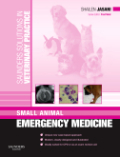
Saunders Solutions in Veterinary Practice consists of a series of practical handbooks on selected medical topics on specific veterinary problems. Case-based, this series is aimed at the small animal veterinary practitioner who has qualified less than 10 years and needs quick access to information and wants to increase his/her confidence on handling that range of cases that cover the spectrum that lies between the simple routine first opinion case and the referral.Saunders Solutions in Veterinary Practice provides additional knowledge that leads to improved skills and practice for veterinary practitioners. Not only practitioners, but also veterinary students nearing the end of their course will find this series very useful to brush up their knowledge in a particular area. The volumes are also written with the veterinary nurse in mind with a particular interest in a specific topic, using 'Nurse Boxes' in the text to guide them to the specific information they need. INDICE: General introduction explaining aims and comments on the series Introduction (topic specific) Outline: how to do a proper clinical exam 25-30 case descriptions covering the following: presenting signs case history clinicalexamination differential diagnosis diagnostic aids case work up nursing aspects epidemiology clinical tips anatomy and physiology refresher treatment options / suggestions - medical treatment options / suggestions- surgical decision making tree (where applicable) prognosis Further reading suggestions Self-Assessment/Questions for further study (True/False statements (with answers); Short Answer Questions (with model answers); Essay Questions (to be confirmed) Sources of specialized services Equipment Drugs Index Content Emergency Medicine volume: 1) the book starts with a number of more informative chapters coveringwhat the author sees as the most fundamental building blocks of this discipline: . Assessing hypovolaemia and dehydration . Fluid therapy . Analgesia . Oxygen supplementation? -2) the volume then works through a selection of the morecommon small animal emergency presentations based around presenting the topicfollowed by short answers on physiology/management. The following areas will be covered in the context of specific presentations where possible, e.g. 'the pale dog', 'the dyspnoeic cat', 'the cat off its hind limbs' etc. Cardiovascular: Pallor - hypoperfusion Anaphylaxis/Anaphylactoid shock Drug reactionSystemic Inflammatory Respiratory Syndrome (SIRS)/sepsis Congestive heart failure Feline Aortic Thromboembolism ? Arrhythmias Atrial fibrillation Ventricular tachycardia/Ventricular Premature Complexes Atrioventricular blocking ? Pericardial effusion Haematopoietic system: Pallor - anaemia Immune-mediated haemolytic anaemia (IMHA) Zinc Immune-mediated thrombocytopenia (ITP) Splenic torsion Respiratory: Dyspnoeic cats Feline Allergic Airway Disease Pleural effusion The coughing dog Upper respiratory tract obstruction Brachycephalic airway obstruction syndrome Laryngeal paralysis Foreign body Mass lesion Tracheal collapse Smoke Inhalation Carbon monoxide poisoning Pulmonary thromboembolism Neurological: Head trauma Spinal problem Disc Trauma Neoplasia Discospondylitis Ischaemicmyelopathy (FCE) Seizures/Status epilepticus Hepatic encephalopathy Vestibular disease Body temperature abnormalities: Hyperthermia Heat stroke Pyrexia Hypothermia Frostbite Alimentary tract/Digestive system: Gastric dilatation/volvulus Small intestinal obstruction Foreign body Intussusception The 'parvo' puppy/Haemorrhagic gastroenteritis Pancreatitis Rectal prolapse Endocrine/Metabolic: Diabetic ketoacidosis Addison's disease Hypoglycaemia Insulinoma Insulin overdose Hypercalcaemia Hepatic lipidosis Urinary system: Feline urethral obstruction ? Canine urethral obstruction Acute renal failure Genital/Reproductive: Dystocia Eclampsia Pyometra Mastitis Uterine prolapse? Trauma Especially road traffic accident cats Diaphragmatic hernia Flail chest (Severe) animal bite injuries Snake bite injury? Thermal burn injury Electrocution Acute abdomen: Haemoabdomen Traumatic Neoplastic rupture Septic peritonitis Uroabdomen Biliary peritonitis Intoxications: Rodenticides Lily Raisin/grape Chocolate NSAIDs Ethylene glycol Acetaminophen Slug bait Methaemoglobinemia Orthopaedic/Musculoskeletal: Long bone fractures Panosteitis Ophthalmology: Red eye Painful eye Blindness? Glaucoma Uveitis Cardiopulmonary resuscitation 3) the third part of the book includes sections on some of the procedures likely to be needed to be performed in emergency cases including: . Thoracocentesis . Abdominocentesis . Cystocentesis . Gastric decompression . Diagnostic peritoneal lavage . Intraosseous catheter placement . Tracheotomy This is followed by a brief description of some basic clinical pathology that is likely to be needed by the general practitioner in emergency cases: . Immune-mediate haemolytic anaemia findings on blood smear examination . Platelets . Intracellular bacteria . Urinary crystals . Urinary casts 4) the book ends with a collection of the drugs and dose rates mentioned throughout the volume for easy access
- ISBN: 978-0-7020-2984-4
- Editorial: Saunders
- Encuadernacion: Rústica
- Páginas: 322
- Fecha Publicación: 23/09/2010
- Nº Volúmenes: 1
- Idioma: Inglés
